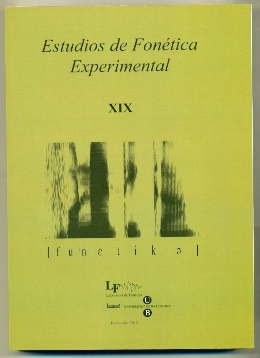Variation and change in stop consonants in the Spanish spoken in Andalucía
Keywords:
stops, voicing, Spanish, Andalucía, variation, changeAbstract
This article investigates the phonetic cues which speakers of Andalusian Spanish use to distinguish words of the type pasta ~ pata, pisto ~ pito, casco ~ caco; words which contain the graphemes Vowel + Sibilante + voiceless Occlusive + Vowel (VSOV) from those in which the sibilant consonant is not present: the sequences Vowel + voiceless Occlusive + Vowel (VOV). The article also investigates the phonetic differences between these latter sequences and the sequences Vowel + spirant Aproximant + Vowel (VAV); minimal pairs such as pipa ~ piba, pito ~ pido, caco ~ cago. The results show that in the first set of sequences (VSOV vs VOV) the most reliable phonetic cue is not the presence of some type of aspiration of the /s/ before the occlusive, since this is not present in a third of the cases, rather the most reliable phonetic cue is to be found in the pronunciation of the occlusive consonants. In the VSOV sequences these are always voiceless and are also statistically more aspirated (and in the East of Andalucía longer) than those of the VOV sequences. Moreover, the occlusives of the VOV sequences are only voiceless 13% of the time whilst they are voiced 69% and are pronounced as approximants 19%. This latter type of pronunciations could lead to a phonetic neutralisation between the sequences VOV and VAV on account of the fact that in the latter sequences the consonant is pronounced as an approximant 66% whilst no consonant is pronounced 34%. It must also be noted that men have more of a tendency to not pronounce the approximants in the sequences VAV and voice the supposedly voiceless occlusives in the VOV sequences.
References
ALVAR, M. (1965): «Notas sobre el español hablado en La Graciosa (Canarias orientales)», Revista de Filología Española, 48, pp. 293-319.
ALVAR, M. (1972): Niveles socioculturales en el habla de Las Palmas de Gran Canaria, Las Palmas de Gran Canaria, Edición del Excmo. Cabildo Insular.
FLÓREZ, L. (1964): «El español hablado en Colombia y su Atlas lingüístico», en Presente y futuro de la lengua española, Madrid, Cultura Hispánica, vol. 1, pp. 5-77.
HERRERA, J. (1989): «Sonorización de oclusivas sordas en Tenerife», en J. Dorta y J. Herrera (eds): Tres estudios de Fonética, La Laguna, Universidad de La Laguna, pp. 111-121.
ISBĂŞESCU, C. (1968): El español en Cuba, Bucarest, Sociedad Rumana de Lingüística Románica.
LADEFOGED, P. (2001): Vowels and Consonants: An Introduction to the Sounds of Languages, Oxford, Blackwell.
LADEFOGED, P. (2003): Phonetic Data Analysis: An Introduction to Instrumental Phonetic Fieldwork, Oxford, Blackwell.
LEWIS, A. M. (2001): Weakening of intervocalic /p, t, k/ in two Spanish dialects: toward the quantification of lenition processes, tesis doctoral, Universidad de Illinois en Urbana-Champaign.
LORENZO RAMOS, A. (1976): El habla de los Silos, Santa Cruz de Tenerife, Confederación Española de Cajas de Ahorro.
MACHUCA AYUSO, M. J. (1997): Las obstruyentes no continuas del español: relación entre las categorías fonéticas y fonológicas en el habla espontánea, tesis doctoral, Universitat Autònoma de Barcelona.
MARTÍNEZ CELDRÁN, E. (2009): «Sonorización de las oclusivas sordas en una hablante murciana: Problemas que plantea», Estudios de Fonética Experimental, XVIII, pp. 253-271.
MARTÍNEZ CELDRÁN, E. y X. L. REGUEIRA (2008): «Spirant approximants in Galician», Journal of the International Phonetic Association, 38, pp. 51-68.
MARTÍNEZ CELDRÁN, E. y A. M. FERNÁNDEZ PLANAS (2007): Manual de fonética española, Barcelona, Ariel.
NAVARRO CORREA, M. (1982): El español hablado en Puerto Cabello, tesis doctoral inédita, Universidad de La Laguna.
O’NEILL, P. (2008): «La fonación murmurada y la preaspiración en el andaluz», en A. Pamies y E. Melguizo (eds.): New Trends in Experimental Phonetics. Special Issue (1) of Language Design, Granada, Método, pp. 195-202.
O’NEILL, P. (2009): «The effect of s-aspiration on occlusives in Andalusian Spanish», en O. Parker Jones y E. Payne (eds.): Oxford University Working Papers in Linguistics, Philology & Phonetics, vol. 12, pp. 73-86.
PENNY, R. (1991): A History of the Spanish Language, Cambridge University Press.
SHOCKEY, L. y F. GIBBON. 1993. «“Stopless stops” in connected English», Speech Research Laboratory. University of Reading Work in Progress, Universidad de Reading, 1-7 (1), pp. 163-180.
STEVENS, K. N. (1998): Acoustic Phonetics, Cambridge, MA, MIT Press.
TORREBLANCA, M. (1976): «La sonorización de las oclusivas sordas en el habla toledana», Boletín de la Real Academia Española, 56, 207, pp.117-165.
TORREBLANCA, M. (1979): «Un rasgo fonológico de la lengua española», Hispanic Review, 47,1, pp. 455-468.
TRUJILLO, R. (1980): «Sonorización de sordas en Canarias», Anuario de Letras de la Universidad Nacional Autónoma de México, 18, pp. 247-265.
Downloads
Published
How to Cite
Issue
Section
License

This work is licensed under a Creative Commons Attribution-NonCommercial-NoDerivatives 4.0 International License.
All articles published online by Estudios de Fonética Experimental are licensed under Creative Commons Attribution-NonCommercial-NoDerivs 4.0 International (CC BY-NC-ND 4.0 DEED), unless otherwise noted. Estudios de Fonética Experimental is an open access journal. Estudios de Fonética Experimental is hosted by RCUB (Revistes Científiques de la Universitat de Barcelona), powered by Open Journal Systems (OJS) software. The copyright is not transferred to the journal: authors hold the copyright and publishing rights without restrictions. The author is free to use and distribute pre and post-prints versions of his/her article. However, preprint versions are regarded as a work-in-progress version used as internal communication with the authors, and we prefer to share postprint versions.




